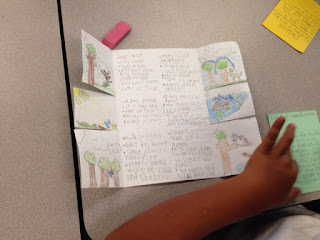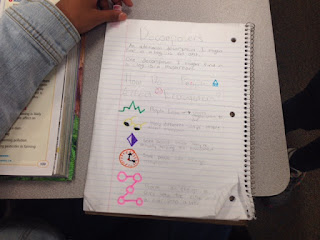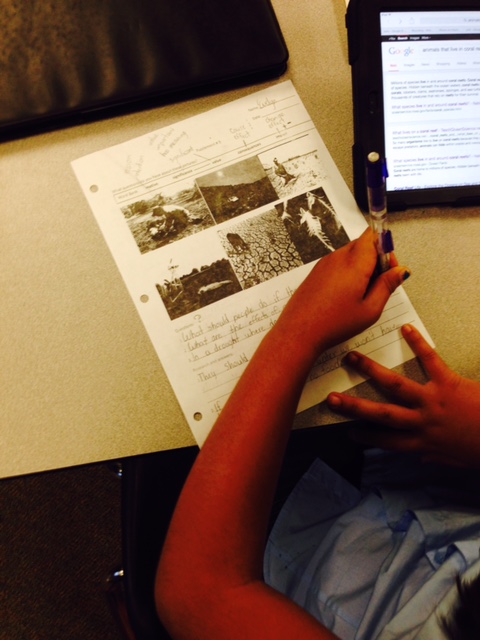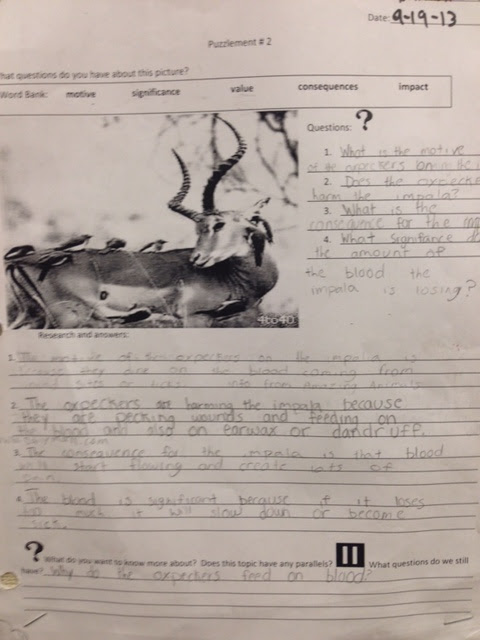Starting your year off right is a MUST! I like to make my students' first day of school rich with information but also fun and memorable. Here are some of my MUST-DO first day of school activities:
1. Hold a Class Meeting
I still remember taking a special ed class in college and my wonderful professor talking about holding class meetings with her students. This is something I've taken away with me ever since and have used class meetings on the first day of school for the last 10 years. The kids and I absolutely love them, and I really think these meetings help to set the tone for the year to come.
Here's How:
Have your students sit in a large circle on the floor (sometimes it turns out looking more like an oval, but that's fine). Explain the rules to the kids. My rules are as follows:
1. You may only talk when you have the stuffed animal in your hand.
2. You do not have to share, but you must listen.
3. You may not have any private conversations.
Pose a question or prompt
My favorite question to start with is "What would your dream teacher be like?" I usually start off the conversation with my stuffed chihuahua in hand, and then I pass the chihuahua clockwise. As students share their responses, I jot down each answer in a personal notebook or post it on the Smartboard. Jotting responses in a notebook allows me to keep a record of what my students really love in a teacher.
Next, I like to tell students to "Describe your dream classroom." Again, this gives me a glimpse into what my students like in a classroom community. This is such valuable information! Sometimes I guide the conversations a bit if I see my kids are stuck on the same types of answers. For example, I might ask something like, "Do you like hands on activities? Do you like to listen to music while working?"
Not only is a class meeting great to hold on the first day of school, but it's also helpful to use when starting off the week, addressing certain problems occurring inside or outside of the classroom, or as a sort of pep talk before important tests or events.
2. Use Cooperative Learning Structures to Teach Routines and Procedures
Even if you're not big on using cooperative learning in the classroom, it's still great to have your students prepared and ready to participate in different structures should the time come. One of the first ways to do this is to make sure your students know which table group and seat number they're sitting at. I like to make it sort of a game/challenge to point to each group one at a time and see if they know which table, and later, seat number they're at. Then, I speed up my pointing and go out of order to try to trick the students. They love it as I point faster and faster and try to mix them up!
In my room, students sit in table groups of anywhere from 4-6 people. I number off my front tables from left to right as tables 1, 2, and 3. The back two tables are numbered 4 and 5. As far as seat numbers go, I start with the seat closest to the front, farthest to the left and work clockwise. The more we practice, the better students get at knowing which seat number they are. For example, I might say, "Person 4, collect all the rulers from your table. Person 2, clean up the post-it notes."
Now that students know their group and seat number, I can practice a few cooperative learning structures with them as I teach routines and procedures. You can always start with the tried and true "Think-Pair-Share" where students turn and talk to their shoulder partner. Students can elaborate on your homework policy, absent work procedures, assignment collection, etc. as they take turns sharing with a partner. Before you do this, make sure students know who their shoulder partner and face partner are. This will help you save time down the line without having to worry about students arguing over who's partners with who.
A Round Robin structure is always an efficient way to make sure all students at a table group get the opportunity to share or discuss a topic. After you teach a procedure, have students take turns around their table or row, sharing the steps of that procedure. Or, you can ask students to give an opinion, ask a question, share a comment, etc. The possibilities are endless, and what's so awesome about this structure is all students have to be involved.
Keeping your overview of your routines and procedures student-involved ensures your class is listening to and learning about what's of the utmost importance to you.
 |
| Students are participating in a RoundRobin structure. They are taking turns to share answers from an activity they had just completed. |
3. Play a Game to Review Class Routines and Procedures
As a kid, I remember how excited and nervous I used to get for the first day of school. I couldn't wait to see my new classroom, meet my new teacher, and become reunited with my friends. However, I also remember finding myself quite bored as I sat inside the classroom listening to my teacher spatting off the rules, routines, and procedures of my new classroom. This is why I realized along the way that kids respond much better to learning this new information when things are engaging! Why not play a game to make sure your pertinent information is sinking in?
Here's How:
1. Put a list of routines and procedures together that you want your students to know about right from the start of school.
2. Now that you've put together a list, create questions about these routines and procedures. Since I have a Smartboard, I use the Smart Notebook software to create a multiple choice quiz.
3. Decide how you want your students to answer these questions. Are they going to work in groups? Partners? Independently? Whole group?
4. If students are working in groups or with partners, you can have them play a board game at the same time, or simply award table points, a round of applause, a cheer, etc. for correct answers. I like to use the free game board I found online.
Board Game: To play the board game, provide each group with dice. One dice for each group will suffice. Put up the first question on the Smartboard. Person 1 in each group will need to answer the question. I then check to see that all groups have a thumb up which means they've answered the question. Next, I reveal the correct answer or poll the class. If Person 1 gets the answer correct, they get to roll the dice and move ahead on the game board. If he or she was incorrect, he/she does not get to roll the dice. Now it's Person 2's turn, and I then move on to question 2 on the Smartboard. This continues until all questions have been answered.
4. If students are working in groups or with partners, you can have them play a board game at the same time, or simply award table points, a round of applause, a cheer, etc. for correct answers. I like to use the free game board I found online.
Board Game: To play the board game, provide each group with dice. One dice for each group will suffice. Put up the first question on the Smartboard. Person 1 in each group will need to answer the question. I then check to see that all groups have a thumb up which means they've answered the question. Next, I reveal the correct answer or poll the class. If Person 1 gets the answer correct, they get to roll the dice and move ahead on the game board. If he or she was incorrect, he/she does not get to roll the dice. Now it's Person 2's turn, and I then move on to question 2 on the Smartboard. This continues until all questions have been answered.
 |
| Sample question I ask my students. I DO NOT let students use my sharpener! LOL! Those things are way too expensive! :) |
 |
| Here's what the game board and game pieces look like. I like to laminate the boards and little cars. |
4. Engage in a Getting to Know You Ice Breaker
Many kids come back to school nervous and afraid of change and the unknown. I know I still get that way myself at times, so a good ice breaker is always a fun way to get kids to communicate with others and get to know their classmates a bit better.
I have a few for sale which you can find using the links below. You can also find many free versions online. I have a Give One Get One in the first link below, and in the second two links I've bundled various engaging activities which include different ice breakers along with the prompts of Depth and Complexity.
https://www.teacherspayteachers.com/Product/Back-to-School-Classbuilding-Find-Someone-Who-1622973”>Back to School Classbuilding Find Someone Who
https://www.teacherspayteachers.com/Product/Depth-and-Complexity-and-The-New-Year-2940762”>Depth and Complexity and The New Year
https://www.teacherspayteachers.com/Product/Back-to-School-Depth-and-Complexity-Frames-Games-and-Activities-Pack-2645396”>Back to School Depth and Complexity Frames, Games, and Activities Pack
If you've read any of my previous blog posts, then you might have figured out that I really love cooperative learning structures! :) A student favorite is called "Jot Thoughts". What I like to do on the first day of school is combine Jot Thoughts with the creation of our class rules. This way, the kids have a buy-in into our rules of the classroom because they feel like they are part of the process--which they are! The good news is you can totally work your magic and make sure that your most important rules are included in the final draft, even if they weren't mentioned prior. You are the teacher, after all... ;)
I have a few for sale which you can find using the links below. You can also find many free versions online. I have a Give One Get One in the first link below, and in the second two links I've bundled various engaging activities which include different ice breakers along with the prompts of Depth and Complexity.
https://www.teacherspayteachers.com/Product/Back-to-School-Classbuilding-Find-Someone-Who-1622973”>Back to School Classbuilding Find Someone Who
https://www.teacherspayteachers.com/Product/Depth-and-Complexity-and-The-New-Year-2940762”>Depth and Complexity and The New Year
https://www.teacherspayteachers.com/Product/Back-to-School-Depth-and-Complexity-Frames-Games-and-Activities-Pack-2645396”>Back to School Depth and Complexity Frames, Games, and Activities Pack
5. Create Your Class Rules Together
Here's How:
1. Seat students in small groups. I like groups of 4-6 kids best.
2. Hand each student a small slip of paper. I love the colored packs of lined slips from Dollar Tree, but any paper will do. You can even use lined paper and have students cut or tear it in half, and share the other half with a neighbor.
3. Model how to tear the paper into small pieces large enough for students to be able to write a sentence or command on. Explain to students that they'll be brainstorming class rules for the classroom and writing each individual rule down on each individual piece of the torn paper.
4. Explain to students that as they write down their rule, they must state what it is to their teammates so that no one else in the group will come up with the same rule more than once (it will still happen no matter what, but this helps a bit). For example, a student might write and say, "Raise your hand to speak." After they write the rule down, they will push the piece of paper to the corner of their desk, or you can have the group form one big pile.
5. When time runs out (you can set a timer), or when you see that most groups are slowing down, you will ask each group to figure out the rules that they think are best and be prepared to share some of them with the rest of the class.
6. From here, I take turns calling on each group and asking for one rule that hasn't been mentioned yet which they feel should be part of our class. As each group shares, I record these ideas either on the Smartboard, white board, or a piece of paper.
7. Finally, after I've heard from each group once or twice, we vote on our top 5-7 rules. It's up to you how many rules you'd like to have in your classroom, but that's about how many I usually choose. Again, if you notice the kids forgot something important, you can ask them about it. For example, "I noticed that we haven't mentioned anything about being on task at all times. How many of you think this is important for our classroom?" I then write it on the board.
8. Sometimes we combine two ideas together if the voting is close and they fit together nicely.
9. Now you can either write down the rules on your poster while the kids are busy, or wait until after school and post it for the next day. :)
https://teach2learncoach.blogspot.com/2016/07/back-to-school-depth-and-complexity.html
2. Hand each student a small slip of paper. I love the colored packs of lined slips from Dollar Tree, but any paper will do. You can even use lined paper and have students cut or tear it in half, and share the other half with a neighbor.
3. Model how to tear the paper into small pieces large enough for students to be able to write a sentence or command on. Explain to students that they'll be brainstorming class rules for the classroom and writing each individual rule down on each individual piece of the torn paper.
4. Explain to students that as they write down their rule, they must state what it is to their teammates so that no one else in the group will come up with the same rule more than once (it will still happen no matter what, but this helps a bit). For example, a student might write and say, "Raise your hand to speak." After they write the rule down, they will push the piece of paper to the corner of their desk, or you can have the group form one big pile.
5. When time runs out (you can set a timer), or when you see that most groups are slowing down, you will ask each group to figure out the rules that they think are best and be prepared to share some of them with the rest of the class.
6. From here, I take turns calling on each group and asking for one rule that hasn't been mentioned yet which they feel should be part of our class. As each group shares, I record these ideas either on the Smartboard, white board, or a piece of paper.
7. Finally, after I've heard from each group once or twice, we vote on our top 5-7 rules. It's up to you how many rules you'd like to have in your classroom, but that's about how many I usually choose. Again, if you notice the kids forgot something important, you can ask them about it. For example, "I noticed that we haven't mentioned anything about being on task at all times. How many of you think this is important for our classroom?" I then write it on the board.
8. Sometimes we combine two ideas together if the voting is close and they fit together nicely.
9. Now you can either write down the rules on your poster while the kids are busy, or wait until after school and post it for the next day. :)
Another way to figure out your class rules is to try this Depth and Complexity Frame FREEBIE! Not only will your students come up with class rules, but they will also respond to other prompts. Click on the link below to get your FREEBIE!
Freebie Link:
https://teach2learncoach.blogspot.com/2016/07/back-to-school-depth-and-complexity.html
6. Give Out a Student Interest/Reading Interest Survey
Getting to know your students' likes and dislikes is so imperative, so why not start on the first day of school? I love to give students an interest survey to get to know them better right off the bat and have something tangible with me that I can refer back to when creating lesson plans and activities. For example, if I know my students love a certain song, I may play it during transitions or even during Mix-Pair-Share. If I know my kids love Pokemon, I may mention some of the characters in my math word problems or examples. The possibilities are endless!
Here's one from Scholastic:
7. Teach a Quick Lesson About Kindness/Acceptance/Diversity/etc.
This doesn't have to be done on the first day of school, but I feel like it's a great way to build a sense of unity, compassion, and community in the classroom. My personal favorite is to read the story Chrysanthemum by Kevin Henkes to my students. In the story, the main character, a little mouse named Chrysanthemum, gets bullied because of her long and unusual name. The activity is detailed below.
Here's How:
1. Locate, print, and cut out a picture of Chrysanthemum.
2. Gather a pair of scissors and some tape.
3. You'll need the book for this part. You can find a recorded reading of the book on YouTube if you don't have it already. Read the story to your students. As you read, cut Chrysanthemum with your scissors every time a character makes fun of Chrysanthemum, but don't tell your students why you're doing this.
4. Each time a character is nice to Chrysanthemum, put a piece of tape on one of her wounds.
5. When the story's over, explain to your class that even though you covered Chrysanthemum's wounds with tape, they were still visible and don't disappear. Relate this to the real world to really hit home.
6. Keep the Chrysanthemum cutout hanging as a reminder about kindness.
Here's a YouTube reading of the story:
https://www.youtube.com/watch?v=t2pCR8YHszM
6. Keep the Chrysanthemum cutout hanging as a reminder about kindness.
Here's a YouTube reading of the story:
https://www.youtube.com/watch?v=t2pCR8YHszM
8. Close the Day with a FUN Classbuilding Activity
After perusing proteacher.net years ago, I came across an awesome forum all about first day of school activities. This is where I first learned about the super fun classbuilding activity, "Saving Fred". I read how students always raved about and remembered this engaging challenge, so I decided to give it a try. Boy were those teachers right! On the last day of school, when my students fill out my teacher created yearbook pages, most always list "Saving Fred" as their most memorable moment for the year.
Kids work in teams (I use table groups) to get Fred, a colorful little gummy worm, back into his life preserver (a gummy saver). The catch is that the students can only use paperclips and teamwork to make this happen. To find this activity, simply search "Saving Fred" on Pinterest or on the Web. You can even find free flow maps students can use to record and illustrate the steps they took to "save Fred". After each team is finished, we always have a nice talk about teamwork and cooperation.
These are just some of the engaging things you can do on the first day of school. I'd love to hear some of your ideas too! Please comment below about your favorite activities for the first day of school. :)
Kids work in teams (I use table groups) to get Fred, a colorful little gummy worm, back into his life preserver (a gummy saver). The catch is that the students can only use paperclips and teamwork to make this happen. To find this activity, simply search "Saving Fred" on Pinterest or on the Web. You can even find free flow maps students can use to record and illustrate the steps they took to "save Fred". After each team is finished, we always have a nice talk about teamwork and cooperation.
These are just some of the engaging things you can do on the first day of school. I'd love to hear some of your ideas too! Please comment below about your favorite activities for the first day of school. :)




















































